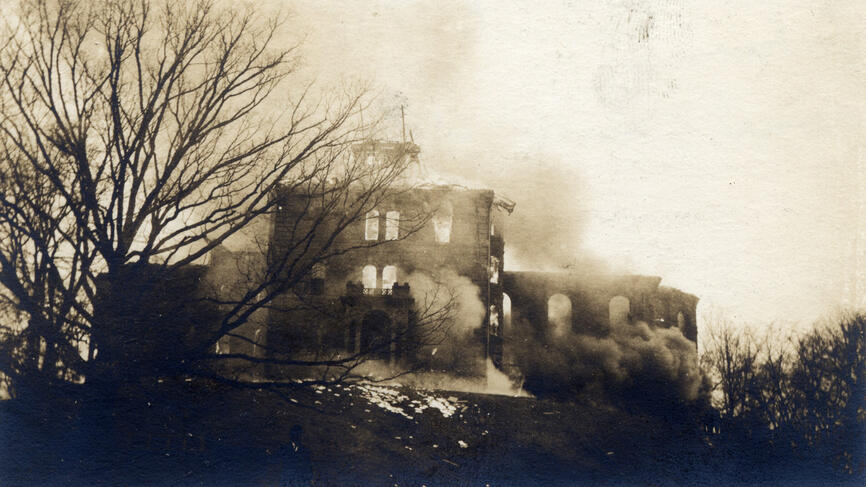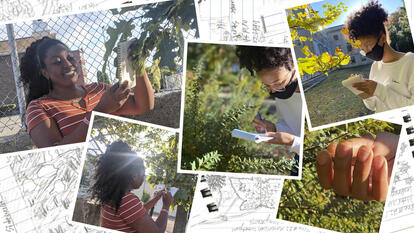
The Caretakers of the Canopy
Every morning, Grant Perodeau and James Connors, Wellesley College’s arborists, meet at the landscape and grounds headquarters located behind the Nehoiden Golf Club at the end of Service Drive, and plan which trees need their attention that day. That can mean anything from pruning dead wood, diagnosing diseases, removing dangerous limbs, monitoring water levels, and planting new trees. “We provide full-scale tree care,” says Perodeau.
Perodeau and Connors, who have been at the College for eight and five years respectively, both previously worked in the private sector. When he arrived on campus, Perodeau says, he was amazed by the number and variety of species. Connors was “stunned at the scale” of the trees at Wellesley. “They’re so mature and well-established,” he says. “Everything is a hundred years old!” says Perodeau.
Kristina Niovi Jones, director of the Wellesley College Botanic Gardens, points out that Wellesley’s campus is different from that of some other colleges. “We did the opposite of Harvard in terms of leveling and flattening the land,” she says. Instead, almost 150 years ago, Wellesley’s founders chose to preserve the natural hills and valleys and constructed buildings around the oldest trees, an unusual choice for the time. “Some of the trees [on campus] predate the founding of the College,” says Jones. Even the “newer” trees on campus, planted when the College was founded in 1875, are now enormous.

“Just think of all the things these trees have witnessed,” says John Olmsted, manager of the College’s landscape and motor pool operations, who has overseen the campus grounds for 21 years. One of Wellesley’s most iconic trees, the large oak on Severance Hill, is well over 200 years old. “The Severance Oak witnessed the fire,” says Olmsted, referring to when College Hall burned down in 1914.
Because so much of New England was cleared to make room for grazing pastures hundreds of years ago, most trees in Massachusetts are relatively young compared with those in some other parts of the country. But not so at Wellesley: “It’s a different age class of trees,” says Olmsted.
Caring for a campus with such plentiful and old trees requires a lot of work. Wellesley’s arborists only prune or remove trees if they are a hazard, like when a dead branch hangs over a path, or are in the way of a major construction project, such as the renovation of the Science Complex. “Or if it is an invasive species,” says Perodeau, who adds that Norway maples are his nemesis. Otherwise the grounds team allows the trees to take shape naturally. Jones calls it “curated wildness.”

And when a tree does need to be removed, it’s only after careful and long deliberation by Olmsted, Perodeau, and Connors, who often bring in an outside arborist for a consultation.
“We plant a lot more trees than we take down,” says Perodeau.
Even with so many incredible trees, everyone has their favorites. Perodeau is a fan of the European beech trees behind Bates, near East Lodge, planted along the original College Road. Olmsted likes the big red maple by the Science Complex, and Connors likes the tulip tree on Severance Green. Jones loves the old white oaks that frame the Edible Ecosystem and the observatory. Alums are often partial to their class trees, and many members of the staff who work in Green Hall like to eat lunch under the large beech tree in Harris Courtyard.
“The trees are foundational,” says Jones, meaning Wellesley would not be Wellesley without its trees. “Having a landscape like this be your backyard is just an incredible opportunity.” In fact, the Paulson Ecology of Place Initiative was founded to take full advantage of Wellesley’s landscape and its trees as a “living laboratory.”
Olmsted, Perodeau, Connors, and the rest of the groundskeeping team are working hard to ensure that Wellesley’s trees will be around for hundreds more years, but the changing climate presents a huge challenge. Drought conditions in the summer often stress the trees now, making it harder for them to fight off diseases. Jones and Olmsted have discussed ways to slow down rainwater so that it reaches the tree roots rather than running down the slopes and causing erosion, and to capture some for irrigation. With increasing summer heat and drought, the team has had to water trees younger than three years old every day in the warmer months.
Tree maintenance on campus is a massive and increasingly difficult job, but faculty, staff, students, and alums can count on Wellesley’s tree team. “We love the trees just as much as they do,” says Olmsted.


